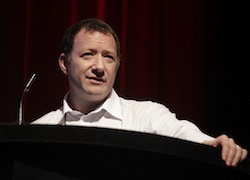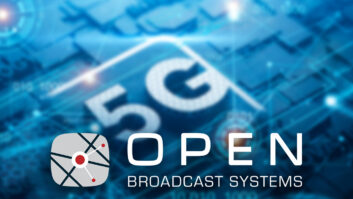
ESPN has led the world in getting to air a national 3D channel based on pioneering live 3D sports production. Where many other networks and operators dipped their toes into 3D around one-off sports events, ESPN has engineered an event-driven channel from scratch.
Jonathan Pannaman, Senior Director Technology, is leading the sportscaster’s 3D task force whose premise he said is to find technology that will allow it “to do ubiquitous production of 3D with an absolute minimum of additional cost” over 2D production.
“That’s a tall order,” said Pannanman in his keynote. “The current approach is based on the film model but it’s our focus to reduce and change that. We have to bring in more automated rig correction, even to the point where there is a single workstation which can manage many tasks.”
The Walt Disney-owned sportscaster actually started working on stereo production over four years ago, beginning with single rig trials and then full game productions shown internally. After producing a USC vs. Ohio State college football game in September 2009 “we realised there was an opportunity” to go further.
Pannaman hinted at some surprise though, when the announcement of a full 3D channel was made at CES in January this year.
“It was a good challenge,” he said. The first step was to coincide the launch with the opening of the World Cup and then to take all 25 3D-produced matches. Baseball and college football events followed with 94 planned in its first year.
A dedicated MCR was built at ESPN’s Bristol, Connecticut HQ playing out live events, idents and commercials although without extensive branding or graphics “just to prove we could build a facility and therefore support a network.”
For production, ESPN took “a path of least resistance” using rigs with every mechanical axis possible adjustable “with someone riding the controls at all times to keep the different parameters in check.
“We got good results but it was very manpower-intensive, adding twelve convergence ops to the head count on even a modest event,” he reported.
They overcame the steadicam problem initially “by finding the four biggest steadicam operators in the US,” he joked. “And by the time we’d worn them out, smaller, lighter rigs had been developed.”
Obtaining stereo from aerial cams is still an ongoing project although Pannaman was enthusiastic about the images obtained from a super-slo-motion camera recording 12-1500fps. “A lot of the US colleges don’t have a fibre infrastructure so we used satellite and compressed the feeds using MPEG-4 to halve the bitrate – not something we’d normally do but it was the only route available.”
Despite spending so much time examining 3D production processes ESPN doesn’t yet have a single, simple approach to 3D. “We take a sport, look at techniques we’ve done and the best way to shoot it and we change it up for each time. The only thing you can generalise is that you need to cut a lot less and take the shots much wider, with fewer cameras — although some of that is economics.”
EPSN’s philosophy on realtime conversions chimes with those of Sky Sports – use where absolutely necessary or where you really only have the luxury of a single camera.
With all these teething problems and economic issues the channel itself may yet be pulled from air and will have its future reviewed in early 2011. “We committed to a full year trial of ESPN 3D and we’re preparing for a second year — but whether this is something we repeat or continue or cut is something that at this point we have very little indication on one way or another,” said Pannaman.
“We’re still not sure what makes sense for 3DTV and we don’t yet see a proven ROI,” he said. “At the same time the buzz is huge and we’re hopeful of a huge push by the Consumer Electronics Association ahead of Christmas to market 3DTV sets and services and we’re seeing more stereo 3D movies and 3D Blu Ray discs come to market.
“Regardless of whether we continue as an event-based network or go to a 24/7 network or switch to VOD, we definitely have to make production efficiencies to make it work. We’ve also got to get more eyeballs looking at 3D to get some idea of acceptance in the marketplace.”
The broadcaster is using ESPN Wide World of Sports, a new theme park experience at Florida’s Disney World and the largest multi-sport facility in the US, to organise a week-long test session for 3D technology this month. All major rig manufacturers and 3D acquisition suppliers are invited to set up their systems on a variety of sports events for a side-by-side shoot out.
“This is a big bang theory to test how each manufacturer’s rigs and conversion technologies work,” said Pannaman. “We will test everything.
“We underestimated the impact of errors,” he admitted. “Any slight vertical misalignment in the cameras or rig transferred down the chain without proper correction can make it painful for the viewer. A lot of work needs to be done to isolate those out of the transmitted picture.”
Answers may be found in an analysis into depth metadata that ESPN is about to undertake. “This is a major topic which impacts events downstream. For example we need to think very carefully about how we place closed captions and graphics in stereo. Do we need to develop some automated alarm that will alert us before we go to air whether a graphic is going to occlude the image? These are monumental challenges which are vital to enable us to produce good 3D.”






